Error Analysis of Common Power Meter Installation Faults on Three-Phase Networks
Abstract
1. Introduction
2. Preliminary Considerations
- (1)
- Discontinuity Faults (DF) appear in the absence of voltage or current signals at the meter’s input terminals (either one or two phases).
- (2)
- Polarity Faults (PF) appear in case the signal polarity (voltage or current) at the meter’s input terminals is reversed with respect to that of the network.
- (3)
- Phase Vector Sequence Faults (VSF) appear when any two wires at the meter’s input terminals are swapped. As a result, the normal phase sequence order of A-B-C is reversed to A-C-B.
- (4)
- Mismatch Faults (MF) of currents and voltages is a discrepancy in the connection of phases A, B, and C, or the polarity of the voltages or currents.
3. Analysis of Meter’s Installation Faults
3.1. Discontinuity Faults
3.2. Polarity Faults
3.3. Sequence Faults
3.4. Mismatch Faults
- phase mismatch
- polarity mismatch
3.5. Combination of Voltage and Current Installation Faults
3.5.1. Combination of Voltage Disconnection Fault and Current Connection Fault
- In combination with disconnected current fault. For a three-phase three-element measurement, (4) yields the same results as in Section 3.1. Here, for the same phases, see (11), whereas K = 1/3 for different phases, see (12), and the phase error is nil, .
- In combination with the current polarity fault. The current polarity fault in the same phase where the voltage is disconnected is superseded by the fact that the voltage is disconnected, see Section 3.1, hence, by (11), . A current polarity fault on another phase (that does not coincide with the phase of the disconnected voltage) leads to a zero-power reading that results in and in all cases.
- In combination with the phase currents sequence fault. Here, for all possible combinations, . Phase fault is dependent on combinations of disconnected phase voltages and incorrect phase current sequence. In case of voltage outages in a phase other than phases with incorrect sequence, . In the event of a voltage cut-off in a phase coinciding with one of the phases with an incorrect sequence—. Consider the obtained results in more detail using the example of an interleaving error of and with disconnected. By (4), the apparent power for this case is:which according to (6) yields , and .
3.5.2. Combined Phase Voltage Sequence and Current Connection Faults
- In combination with current disconnection faults. For all possible combinations, . In case of current disconnection, the phase error for phases with the correct sequence is , whereas in case of current disconnection in a phase with incorrect sequence, .
- In combination with polarity errors of the current connection. For all possible combinations, . Phase error in case of current disconnection in phases with the correct sequence is , whereas in case of current interruption in a phase with incorrect sequence, .
- In combination with current vectors sequence fault. For all possible combinations, . When the sequence errors occur in the same phases of currents and voltages coincide, the phase error is , whereas in cases of mismatch, the phase error is .
- Combination current and voltage mismatch faults result in zero values , .
3.5.3. Combination of Mismatch Faults Caused by Incorrect Connection of Voltage Measuring Circuits with Current Connection Faults
- In combination with the current disconnection fault.
- 2.
- In combination with connection polarity errors.
- 3.
- In combination with a sequence of phase vectors of current faults.
- 4.
- Combination with mismatch errors caused by incorrect connection of the current measuring circuits.
4. Simulation Results
5. Experimental Results
6. Future Work
7. Conclusions
Author Contributions
Funding
Data Availability Statement
Conflicts of Interest
Nomenclature
| the phase voltage reading of the power meter | |
| the phase current reading of the power meter | |
| the rotation operator | |
| P | the active power |
| Q | the reactive power |
| WP | the active energy |
| WQ | the reactive energy |
| the measured complex power | |
| the complex power received by the consumer | |
| the normalized complex power | |
| the compliance factor (CF) | |
| K | the absolute value of CF |
| ∆ | is the phase of CF |
| V0 | the zero-sequence voltage |
| the positive-sequence voltage | |
| the negative-sequence voltage | |
| zero-sequence asymmetry factor | |
| the negative-sequence asymmetry factor |
References
- $96 Billion Is Lost Every Year to Electricity Theft. Available online: https://www.prnewswire.com/news-releases/96-billion-is-lost-every-year-to-electricity-theft-300453411.html (accessed on 8 April 2024).
- Gu, F. Analysis on Phase Shift Method of Stealing Electricity Meter Wiring. In Proceedings of the International Conference on Education, Management, Commerce and Society (EMCS 2015), Shenyang, China, 29–31 January 2015. [Google Scholar]
- Ebel, D.; Kurth, P. Financial losses of wrong meter installation—The importance of training. Smart Energy Int. 2008. [Google Scholar]
- Shcherbakova, P.; Senderovych, G.; Abramovitz, A. Revisiting the active power direction method. IET Gener. Transm. Distrib. 2021, 15, 1056–1069. [Google Scholar] [CrossRef]
- ANSI C12.20-2010; American National Standard for Electricity Meters-0.2 and 0.5 Accuracy Classes. ANSI: Washington, DC, USA, 2018.
- IEC 62053-22; Electricity Metering Equipment (ac)–Particular Requirements Part 22: Static Meters for Active Energy (Classes 0.2 S and 0.5 S). IEC: Geneva, Switzerland, 2003.
- IEEE Std 1889-2018; IEEE Guide for Evaluating and Testing the Electrical Performance of Energy Saving Devices. IEEE: Piscataway, NJ, USA, 2019; pp. 1–46. [CrossRef]
- Pazderin, A.V.; Egorov, A.O.; Eroshenko, S.A. The energy meters allocation in electric systems on the basis of observability theory. In Proceedings of the 2010 9th International Conference on Environment and Electrical Engineering, Prague, Czech Republic, 16–19 May 2010; pp. 167–170. [Google Scholar] [CrossRef]
- Baumeler, F.; Ebel, D. How to discover circuit errors in meter installations. In Proceedings of the Ninth International Conference on Metering and Tariffs for Energy Supply 1999 (Conf. Publ. No. 462), Birmingham, UK, 25–28 May 1999; pp. 234–238. [Google Scholar] [CrossRef]
- Ford, V.; Siraj, A.; Eberle, W. Smart grid energy fraud detection using artificial neural networks. In Proceedings of the 2014 IEEE Symposium on Computational Intelligence Applications in Smart Grid (CIASG), Orlando, FL, USA, 9–12 December 2014; pp. 1–6. [Google Scholar] [CrossRef]
- Wang, B.; Dong, X.; Pan, Z.; Bo, Z.; Yip, T. Bad Data Identification for Voltage Sag State Estimation in Distribution System with Wind Farm Connections. In Proceedings of the 2011 46th International Universities’ Power Engineering Conference (UPEC), Soest, Germany, 5–8 September 2011; pp. 1–5. [Google Scholar]
- Murawwi, E.A.; Mardiana, R.; Su, Q. Effect of terminal connections on VSFRA results of three-winding power tranVSFormers. In Proceedings of the 2011 2nd International Conference on Electric Power and Energy Conversion Systems (EPECS), Sharjah, United Arab Emirates, 15–17 November 2011; pp. 1–6. [Google Scholar] [CrossRef]
- Christopher, A.V.; Swaminathan, G.; Subramanian, M.; Thangaraj, P. Distribution line monitoring system for the detection of power theft using power line communication. In Proceedings of the 2014 IEEE Conference on Energy Conversion (CENCON), Johor Bahru, Malaysia, 13–15 October 2014; pp. 55–60. [Google Scholar] [CrossRef]
- Shah, A.L.; Mesbah, W.; Al-Awami, A.T. An Algorithm for Accurate Detection and Correction of Technical and Nontechnical Losses Using Smart Metering. IEEE Trans. Instrum. Meas. 2020, 69, 8809–8820. [Google Scholar] [CrossRef]
- Mendiola, J.E.; Pedrasa, M.A.A. Detection of Pilferage in an AMI-Enabled Low-Voltage Network Using Energy Reading Anomalies. In Proceedings of the 2019 International Conference on Smart Grid Synchronized Measurements and Analytics (SGSMA), College Station, TX, USA, 21–23 May 2019; pp. 1–6. [Google Scholar] [CrossRef]
- Henriques, H.; Barbero, A.; Ribeiro, R.; Fortes, M.; Zanco, W.; Xavier, O.; Amorim, R. Development of adapted ammeter for fraud detection in low-voltage installations. Measurement 2014, 56, 1–7. [Google Scholar] [CrossRef]
- Ahmad, T.; Chen, H.; Wang, J.; Guo, Y. Review of various modeling techniques for the detection of electricity theft in smart grid environment. Renew. Sustain. Energy Rev. 2018, 82, 2916–2933. [Google Scholar] [CrossRef]
- Himeur, Y.; Ghanem, K.; Alsalemi, A.; Bensaali, F.; Amira, A. Artificial intelligence based anomaly detection of energy consumption in buildings: A review, current trends and new perspectives. Appl. Energy 2021, 287, 1166. [Google Scholar] [CrossRef]
- Mesbah, W. Securing Smart Electricity Meters Against Customer Attacks. IEEE Trans. Smart Grid 2018, 9, 101–110. [Google Scholar] [CrossRef]
- Blakely, L.; Reno, M.J.; Feng, W.-C. Spectral Clustering for Customer Phase Identification Using AMI Voltage Timeseries, 2019. In Proceedings of the IEEE Power and Energy Conference at Illinois (PECI), Champaign, IL, USA, 28 February–1 March 2019; pp. 1–7. [Google Scholar] [CrossRef]
- Luan, W.; Peng, J.; Maras, M.; Lo, J.; Harapnuk, B. Smart Meter Data Analytics for Distribution Network Connectivity Verification. IEEE Trans. Smart Grid 2015, 6, 1964–1971. [Google Scholar] [CrossRef]
- Trevizan, R.D.; Reno, M.J. Distribution System State Estimation Sensitivity to Errors in Phase Connections. In Proceedings of the 2021 IEEE 48th Photovoltaic Specialists Conference (PVSC), Fort Lauderdale, FL, USA, 20–25 June 2021; pp. 1049–1056. [Google Scholar] [CrossRef]
- Power Quality Analyzers. Available online: https://www.satec-global.com/PowerQualityAnalyzers (accessed on 8 April 2024).
- Electrical Submetering Equipment for Building Management Systems (BMS). Available online: https://shop.dentinstruments.com/collections/building-submetering (accessed on 8 April 2024).
- Power Quality Analyzers and Meter. Available online: https://www.elspec-ltd.com/metering-protection/power-quality-analyzers (accessed on 8 April 2024).
- Power Logger User’s Manual, FLUKE 1736/1738. Available online: https://dam-assets.fluke.com/s3fs-public/173x____umeng0200_0.pdf?2JZuc3jb6JoHuQ163Haf5bzCdt1HSMvE (accessed on 8 April 2024).
- IEEE Std 1159-2019; IEEE Recommended Practice for Monitoring Electric Power Quality. IEEE Std: Piscataway, NJ, USA, 2009; pp. 1–98.
- EN 50160; Voltage Characteristics in Public Distribution Systems. UK. 2004. Available online: https://powerquality.blog/2021/07/22/standard-en-50160-voltage-characteristics-of-public-distribution-systems/ (accessed on 8 April 2024).
- ANSI C84.1; American National Standard for Electric Power Systems and Equipment. ANSI: Washington, DC, USA, 2020.
- Kuwałek, P.; Wiczyński, G. Dependence of Voltage Fluctuation Severity on Clipped Sinewave Distortion of Voltage. IEEE Trans. Instrum. Meas. 2021, 70, 2006008. [Google Scholar] [CrossRef]
- Wiczyński, G.; Kuwałek, P. Voltage Distortion Influence on Flicker Severity Measurement by AMI Energy Meters. IEEE Trans. Ind. Electron. 2022, 69, 10684–10693. [Google Scholar] [CrossRef]
- Szolik, I.; Kovac, K.; Smiesko, V. Influence of noncoherent sampling upon an error of power quality parameters measurement. Meas. Sci. Rev. 2005, 5, 35–38. [Google Scholar]
- Sun, J.; Sun, H.; Jiang, J. An improved modulation method for low common-mode current non-isolated series simultaneous power supply dual-input inverters for new energy generation applications. Electr. Eng. 2024. [Google Scholar] [CrossRef]

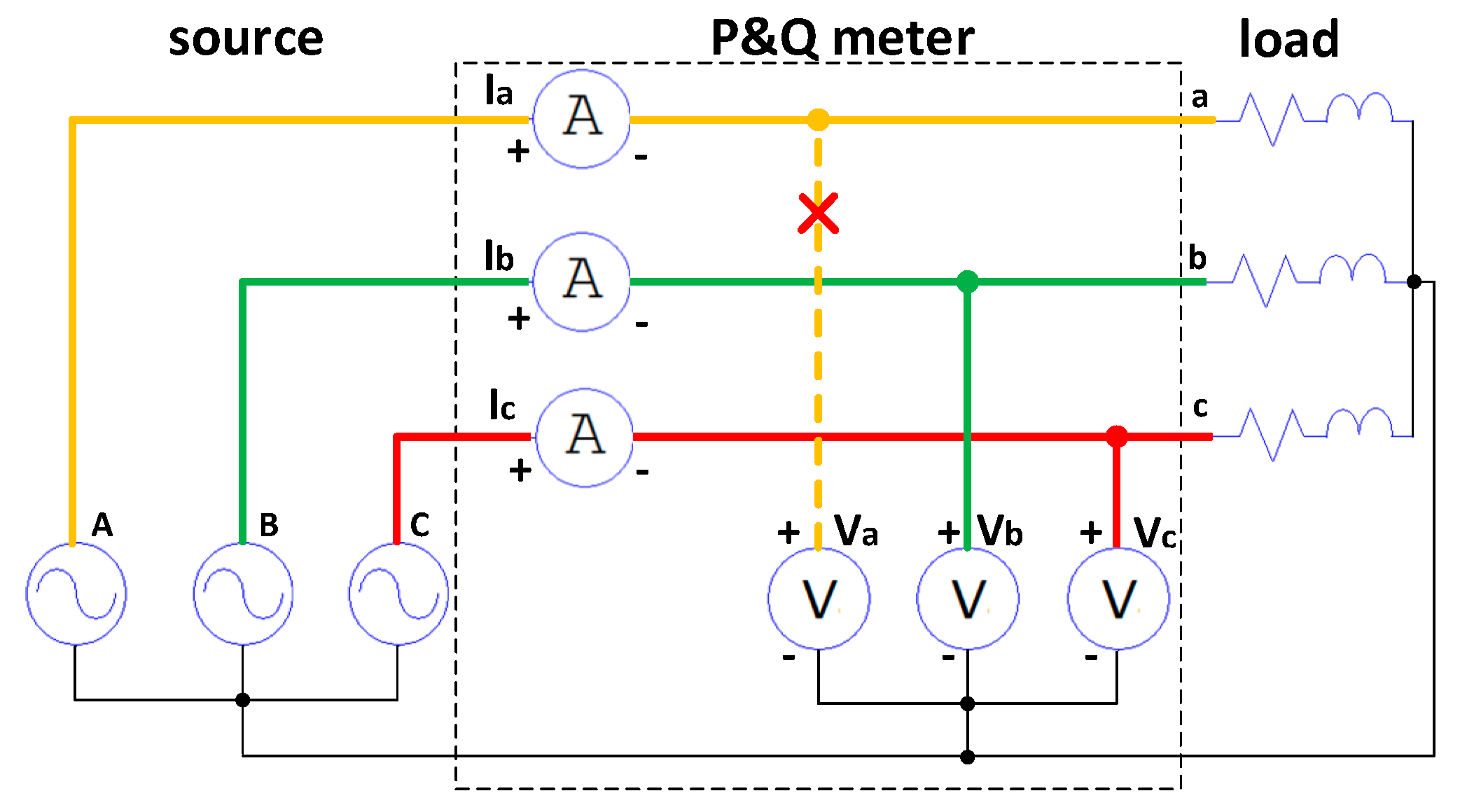
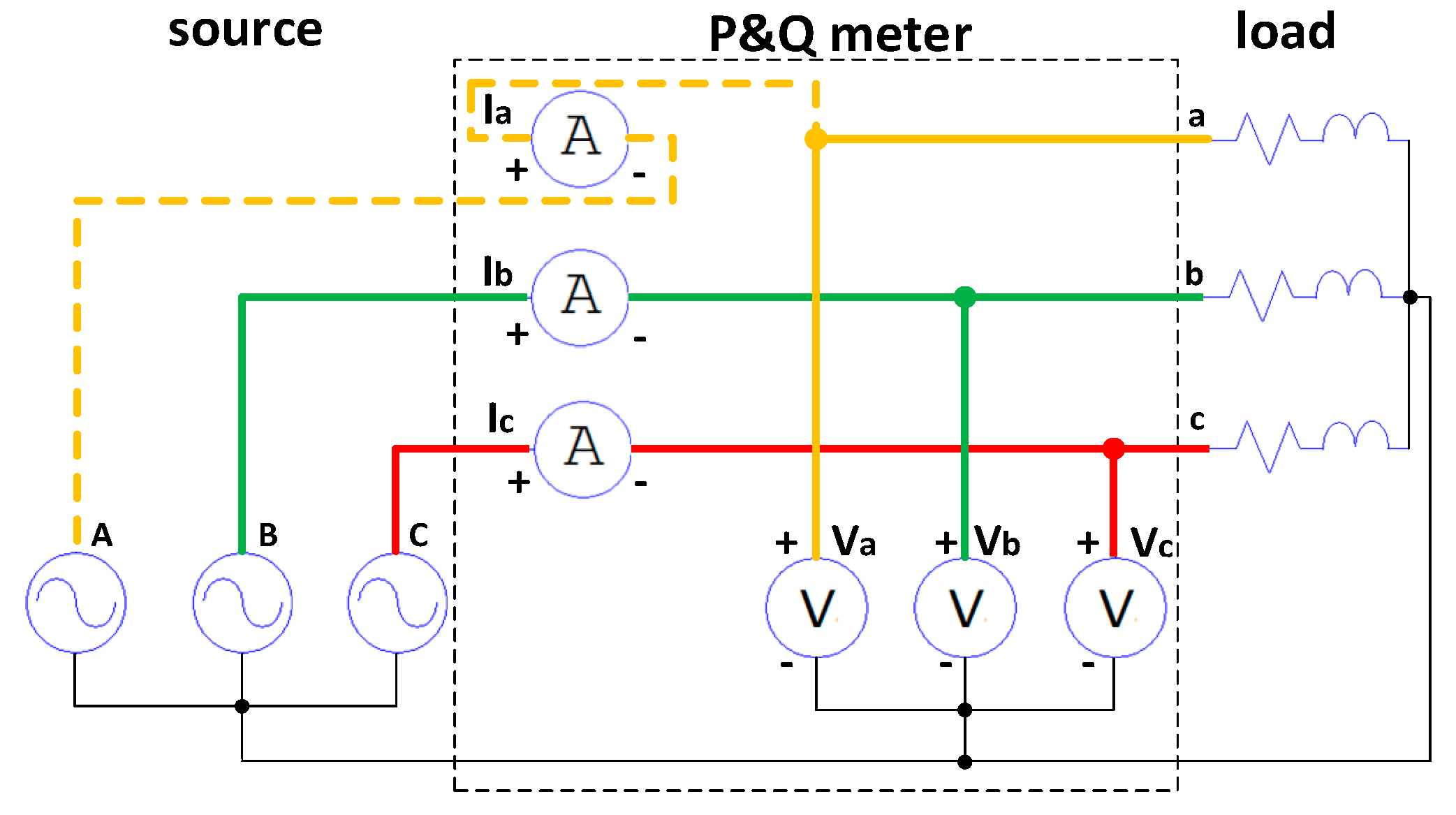
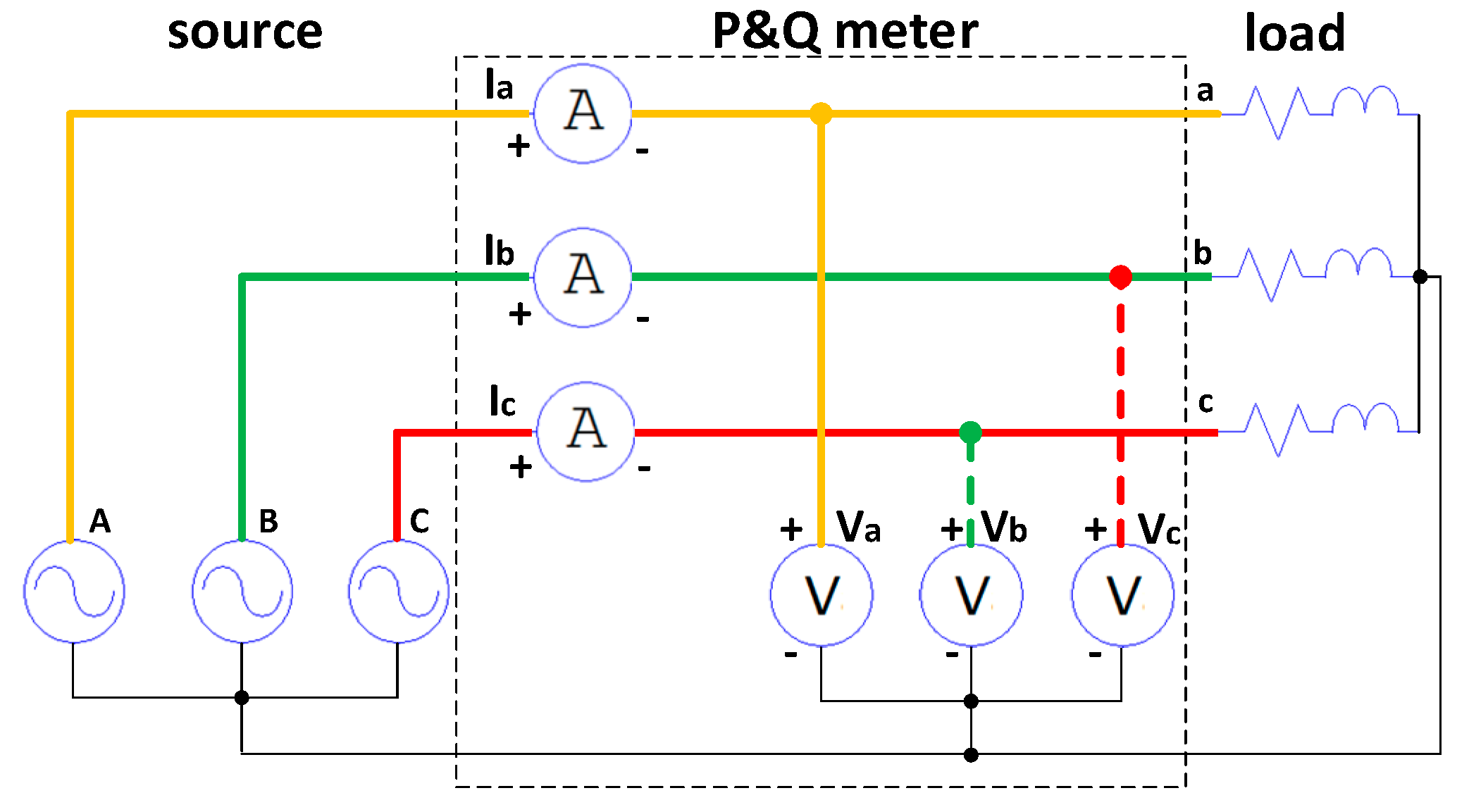
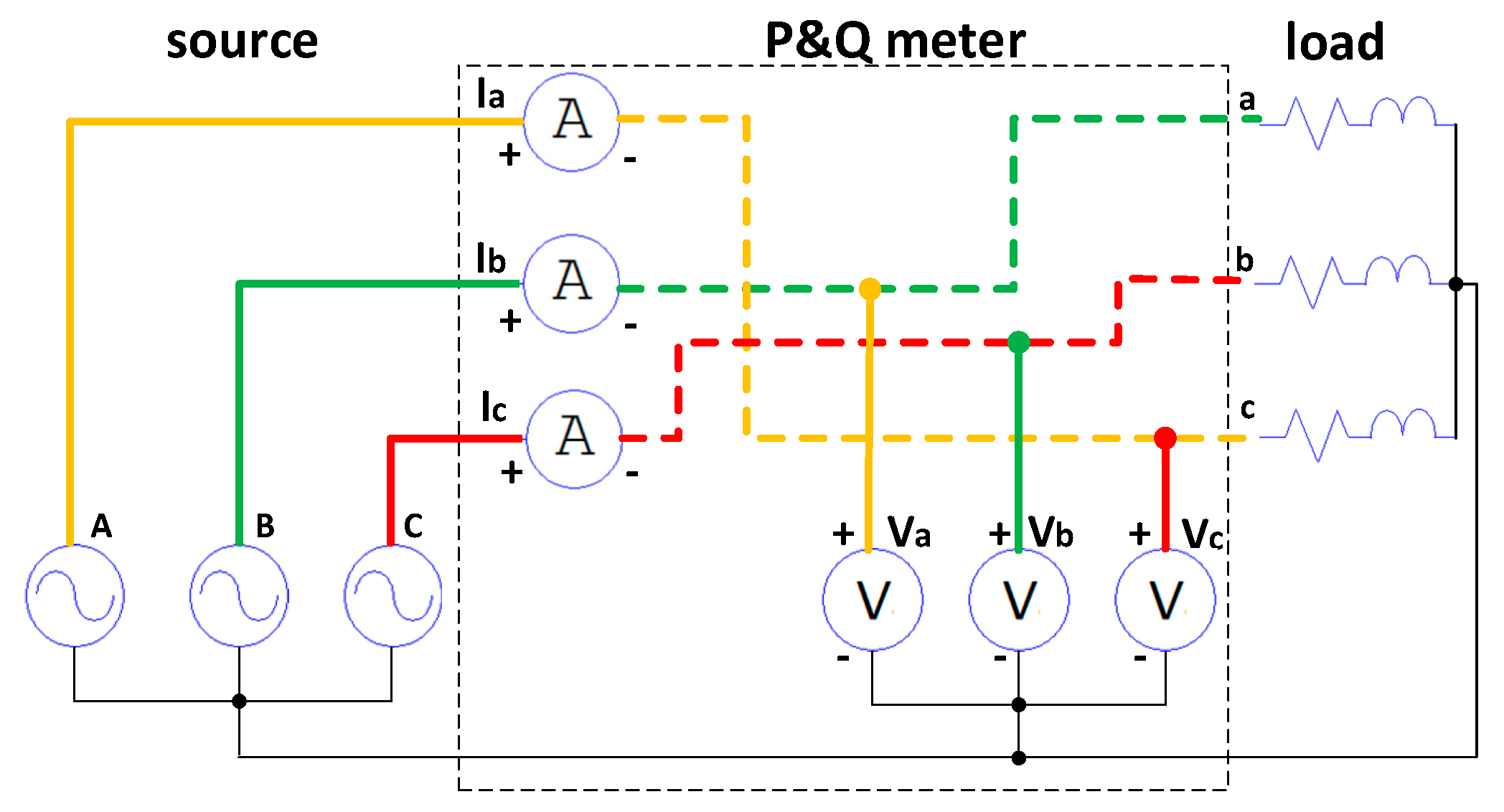
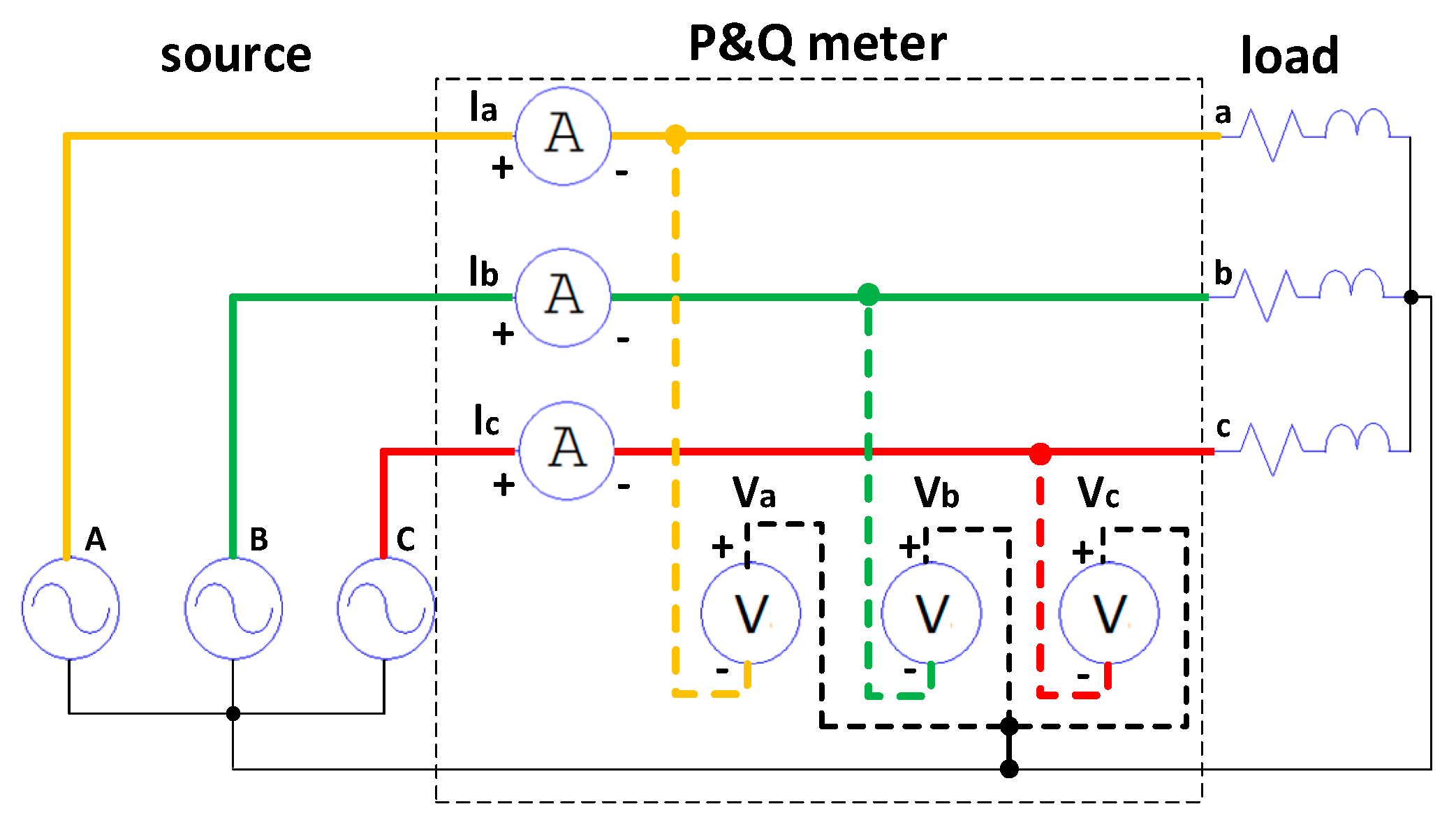
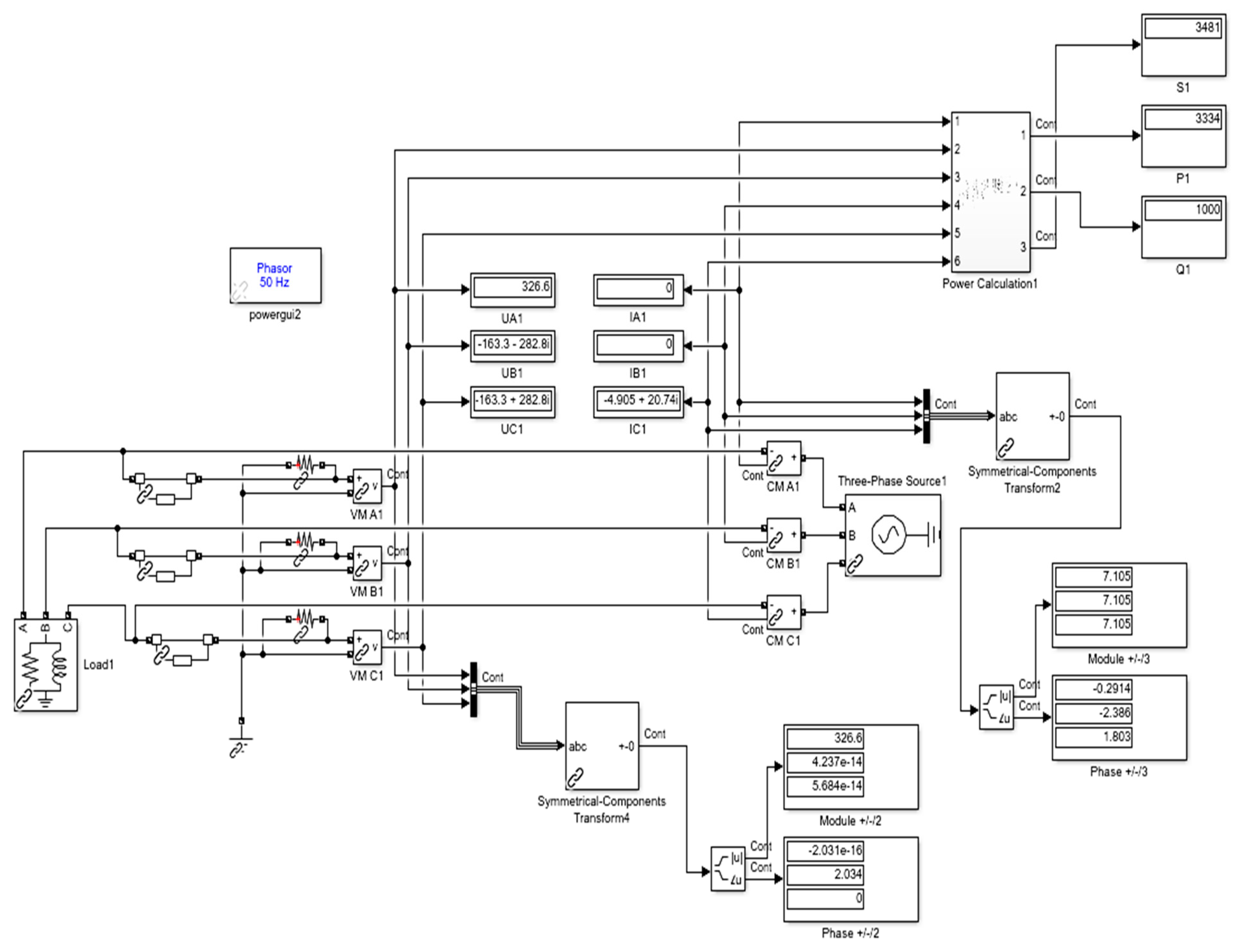
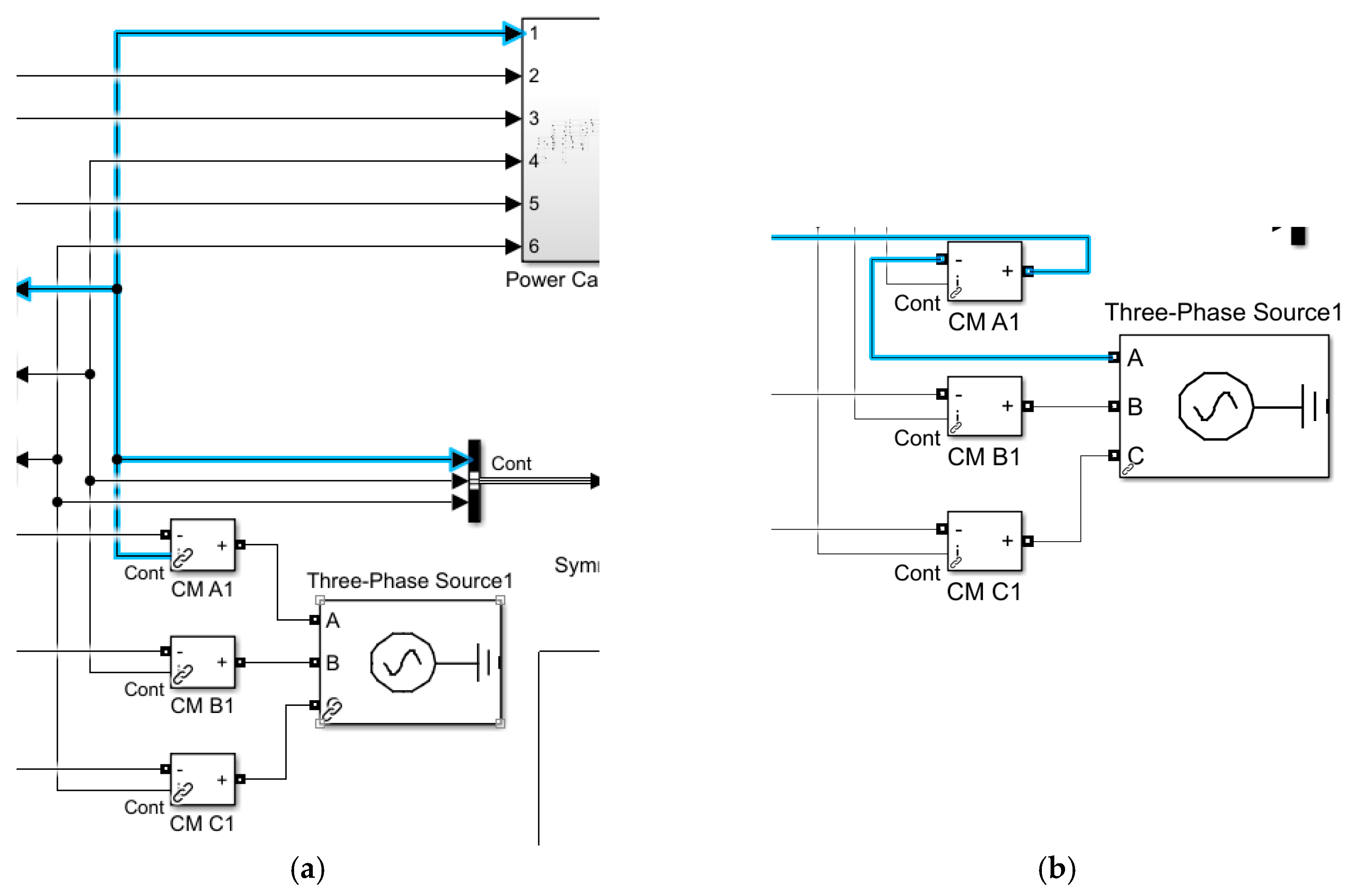

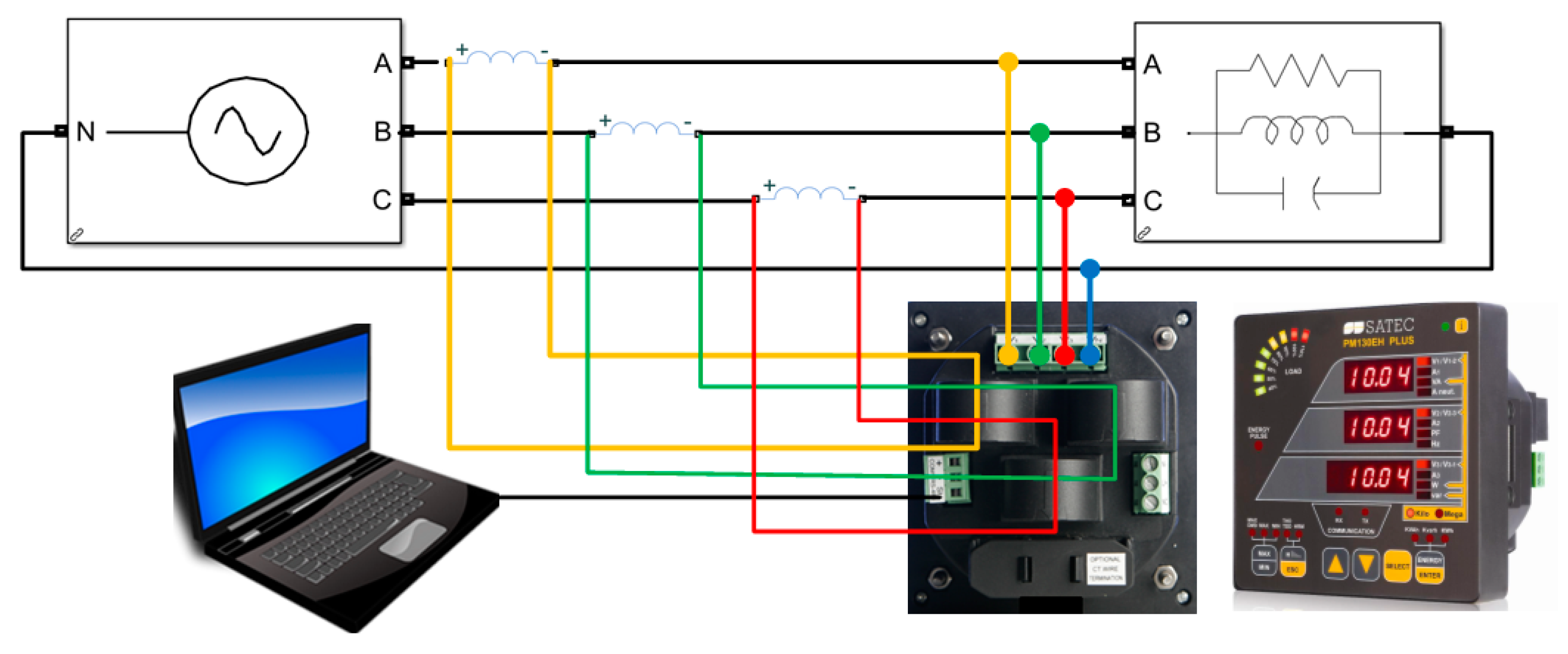
| Fault Type | V Circuits | I Circuits | S | % % | |||||
|---|---|---|---|---|---|---|---|---|---|
| A | B | C | A | B | C | K | |||
| Discontinuity Faults (DF) | x | x | x | 2/3 | 0 | 50 | |||
| x | x | x | 2/3 | 0 | 0 | ||||
| x | x | x | x | x | x | 2/3 | 0 | 50 | |
| x x | x x | x x | 1/3 | 0 | 100 | ||||
| x x | x x | x x | 1/3 | 0 | 0 | ||||
| x x | x x | x x | x x | x x | x x | 1/3 | 0 | 50 | |
| Polarity Faults (PF) | x | x | x | 1/3 | 0 | 200 | |||
| x | x | x | 1/3 | 0 | 0 | ||||
| Vector Sequence Faults (VSF) | 0 | - | |||||||
| 0 | - | 0 | |||||||
| Mismatch Faults (MF) | − | − | − | 1 | 2/3 −2/3 | 0 | |||
| Fault Type on I Input | 1. DF | 2. PF | 3. VSF | 4. MF (ABCV) | |||||||||||||||||||||
|---|---|---|---|---|---|---|---|---|---|---|---|---|---|---|---|---|---|---|---|---|---|---|---|---|---|
| Fault Type on V Input | A | B | C | A | B | C | AB | BC | CA | -(ABC) | BCA | CAB | |||||||||||||
| K | K | K | K | K | K | K | K | K | K | K | K | ||||||||||||||
| 1. DF | A | 2/3 | 0 | 1/3 | 0 | 1/3 | 0 | 2/3 | 0 | 0 | - | 0 | - | 1/3 | 1/3 | 1/3 | 2/3 | 2/3 | 2/3 | ||||||
| B | 1/3 | 0 | 2/3 | 0 | 1/3 | 0 | 0 | - | 2/3 | 0 | 0 | - | 1/3 | 1/3 | 1/3 | 2/3 | 2/3 | 2/3 | |||||||
| C | 1/3 | 0 | 1/3 | 0 | 2/3 | 0 | 0 | - | 0 | - | 2/3 | 0 | 1/3 | 1/3 | 1/3 | 2/3 | 2/3 | 2/3 | |||||||
| 2. PF | A | 2/3 | 0 | 0 | - | 0 | - | 1 | 0 | 1/3 | 1/3 | 2/3 | 2/3 | 2/3 | 1/3 | 1/3 | 1/3 | ||||||||
| B | 0 | - | 2/3 | 0 | 0 | - | 1/3 | 1 | 0 | 1/3 | 2/3 | 2/3 | 2/3 | 1/3 | 1/3 | 1/3 | |||||||||
| C | 0 | - | 0 | - | 2/3 | 0 | 1/3 | 1/3 | 1 | 0 | 2/3 | 2/3 | 2/3 | 1/3 | 1/3 | 1/3 | |||||||||
| 3. VSF | AB | 1/3 | 1/3 | 2/3 | 2/3 | 2/3 | 1 | 0 | 1 | 1 | 0 | - | 0 | - | 0 | - | |||||||||
| BC | 1/3 | 1/3 | 1/3 | 2/3 | 2/3 | 2/3 | 1 | 1 | 0 | 1 | 0 | - | 0 | - | 0 | - | |||||||||
| CA | 1/3 | 1/3 | 1/3 | 2/3 | 2/3 | 2/3 | 1 | 1 | 1 | 0 | 0 | - | 0 | - | 0 | - | |||||||||
| 4. MF (ABCI) | -(ABC) | 2/3 | 2/3 | 2/3 | 1/3 | 1/3 | 1/3 | 0 | - | 0 | - | 0 | - | 1 | 0 | 1 | 1 | ||||||||
| BCA | 2/3 | 2/3 | 2/3 | 1/3 | 1/3 | 1/3 | 0 | - | 0 | - | 0 | - | 1 | 1 | 0 | 1 | |||||||||
| CAB | 2/3 | 2/3 | 2/3 | 1/3 | 1/3 | 1/3 | 0 | - | 0 | - | 0 | - | 1 | 1 | 1 | 0 | |||||||||
| Fault Type | Meter’s V Input | Meter’s I Input | Experiment | Simulation | ||||||||||||
|---|---|---|---|---|---|---|---|---|---|---|---|---|---|---|---|---|
| P, Q | % | P, Q | % | |||||||||||||
| A | B | C | A | B | C | A | B | C | SABC | SABC | ||||||
| 1. DF | no distortion | 0.423 | −0.116 | 0.433 | −0.112 | 0.43 | −0.109 | 1.286 − j0.337 1(0) | 0.8/1.3 | 10 + j3 1(0) | 0/0 | |||||
| x | 0 | 0 | 0.434 | −0.112 | 0.428 | −0.110 | 0.862 − j0.222 ≈⅔ (0) | 49.5/50.6 | 6.67 + j2 ⅔ (0) | 50/50 | ||||||
| x | 0.425 | −0.116 | 0.433 | −0.113 | 0 | 0 | 0.858 − j0.229 ≈⅔ (0) | 49.2/50.8 | 6.67 + j2 ⅔ (0) | 50/50 | ||||||
| x | 0 | 0 | 0.428 | 0.100 | 0.429 | 0.105 | 0.857 − j0.205 ≈⅔ (0) | 1.1/0.5 | 6.67 + j2 ⅔ (0) | 0/0 | ||||||
| x | 0.433 | 0.100 | 0 | 0 | 0.428 | 0.105 | 0.861 − j0.205 ≈⅔ (0) | 0.9/0.6 | 6.67 + j2 ⅔ (0) | 0/0 | ||||||
| x | x | 0.431 | 0.105 | 0 | 0 | 0 | 0 | 0.431 − j0.105 ≈⅓ (0) | 100/100 | 3.34 + j1 ⅓ (0) | 100/100 | |||||
| x | x | 0 | 0 | 0 | 0 | 0.429 | 0.106 | 0.429 − j0.106 ≈⅓ (0) | 0/0 | 3.34 + j1 ⅓ (0) | 0/0 | |||||
| x | x | 0 | 0 | 0 | 0 | 0.372 | 0.106 | 0.372 + j0.106 ≈⅓(0) | 50.9/49.1 | 3.34 + j1 ⅓ (0) | 50/50 | |||||
| x | −0.423 | 0.117 | 0.436 | −0.115 | 0.432 | −0.109 | −0.445 − j0.107 ≈⅓(0) | 0.7/1.4 | 3.34 + j1 ⅓ (0) | 0/0 | ||||||
| 2. PF (I) | x | - | - | - | - | - | - | - | - | 3.34 + j1 ⅓ (0) | 200/200 | |||||
| x | x | - | - | - | - | - | - | - | - | −3.34 − j1 ⅓ (0) | 200/200 | |||||
| −0.316 | −0.318 | −0.115 | 0.435 | 0.432 | −0.113 | −0.001 + j0.004 ≈0(0) | 0 | |||||||||
| 3. VSF | −0.111 | 0.431 | −0.312 | −0.316 | 0.435 | −0.113 | −0.012 + j0.002 ≈0(0) | 0/0 | 0 | 0/0 | ||||||
| − | − | − | −0.427 | 0.117 | −0.438 | 0.115 | −0.433 | 0.112 | −1.298 + j0.344 ≈1(π) | 0.7/1.1 | −10 − j3 1(π) | 0/0 | ||||
| 4. MF | −0.318 | −0.314 | −0.313 | −0.322 | −0.314 | −0.316 | −0.945 − j0.952 ≈1(⅔π) | 0.7/0.9 | −7.62 + j7.23 1(⅔π) | 0/0 | ||||||
| −0.109 | 0.429 | −0.121 | 0.435 | −0.119 | 0.428 | −0.349 + j1.292 ≈1(−⅔π) | 0.9/0.7 | −2.45 − j10.0 1(−⅔π) | 0/0 | |||||||
| −0.114 | 0.427 | −0.114 | 0.429 | −0.121 | 0.428 | −0.349 + j1.284 ≈1(−⅔π) | 0.8/1 | −2.41-j10.16 1(−⅔π) | 0/0 | |||||||
Disclaimer/Publisher’s Note: The statements, opinions and data contained in all publications are solely those of the individual author(s) and contributor(s) and not of MDPI and/or the editor(s). MDPI and/or the editor(s) disclaim responsibility for any injury to people or property resulting from any ideas, methods, instructions or products referred to in the content. |
© 2024 by the authors. Licensee MDPI, Basel, Switzerland. This article is an open access article distributed under the terms and conditions of the Creative Commons Attribution (CC BY) license (https://creativecommons.org/licenses/by/4.0/).
Share and Cite
Senderovych, G.; Scherbakova, P.; Abramovitz, A. Error Analysis of Common Power Meter Installation Faults on Three-Phase Networks. Electronics 2024, 13, 1501. https://doi.org/10.3390/electronics13081501
Senderovych G, Scherbakova P, Abramovitz A. Error Analysis of Common Power Meter Installation Faults on Three-Phase Networks. Electronics. 2024; 13(8):1501. https://doi.org/10.3390/electronics13081501
Chicago/Turabian StyleSenderovych, Gennady, Polina Scherbakova, and Alexander Abramovitz. 2024. "Error Analysis of Common Power Meter Installation Faults on Three-Phase Networks" Electronics 13, no. 8: 1501. https://doi.org/10.3390/electronics13081501
APA StyleSenderovych, G., Scherbakova, P., & Abramovitz, A. (2024). Error Analysis of Common Power Meter Installation Faults on Three-Phase Networks. Electronics, 13(8), 1501. https://doi.org/10.3390/electronics13081501








